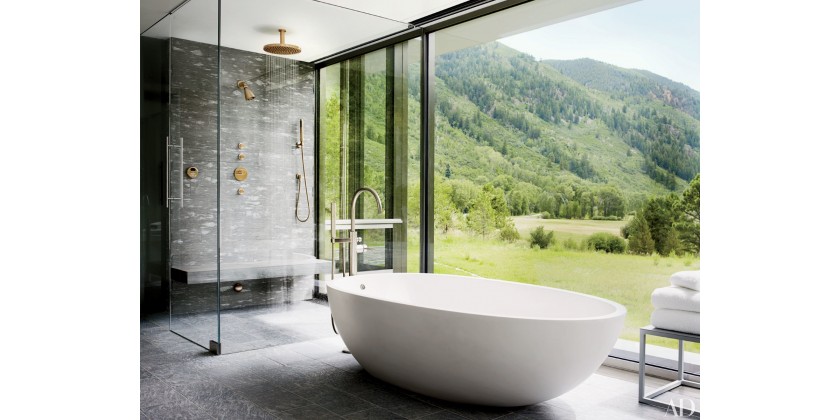
Nothing is more soothing for a nighttime ritual as drawing a hot bath. A soak in the bathtub can enhance the mood, promote better sleep, and reduce pain and inflammation.
The bathtub is the staple fixture of any bathroom design. From large and luxurious to compact and understated, it sets the tone of the bathroom's style. Those who plan to remodel their bathroom or build a new home face an important design decision.
Which is better, freestanding bathtubs or built-in?
Both are fine fixture options and offer the right blend of function and style. Both add elegant flair while boosting the value of your house or flat.
So, which bathtub is right to outfit your bathroom with? Read on for everything you need to know about both of these bathtub styles.
Making a Statement with Freestanding Bathtubs
From modern elegance to vintage charm, freestanding bathtubs make quite a statement in the bathroom. The beauty of their non-contained curves creates a dramatic focal point.
This tub style stands by itself, needing no support from walls. The tub gets finished on all sides, with all angles exposed. It offers a true spa-like soaking experience.
Design Features
Stand-alone tubs are an eye-catching way to enhance the style of your bathroom. They offer a range of design elements, materials, and styles.
Go vintage chic with a clawfoot tub. Or stay traditional with a pedestal or skirted design. Popular materials consist of cast iron, ceramic, stone, marble, or concrete.
Freestanding tubs get built for bathing, not showering. Certain models do have a hand-held spray nozzle. This comes attached to the fixture and allows you to rinse yourself off after your bath.
You will still need a separate shower installed in the bathroom. Shower curtains do not work well for aesthetic or comfort when added to a freestanding tub. Roman showers are currently trending, offering a large doorless space.
Some people have noted that this tub style doesn't keep bathwater hot for long periods. Yet, it's a simple fix by adding more hot water into the tub if it starts to become lukewarm. Acrylic tubs are also said to hold heat better than cast iron models.
Types of Freestanding Models
Freestanding models are larger in size and round in shape. Here are a few common styles to consider:
- Single-Ended: One of the tub's ends is more rounded to allow your back to rest against it. The non-sloped side holds the faucet and drain.
- Double-Ended: Both ends of the tub get rounded, allowing you to lounge at either end. The faucet and drains get installed in the middle of the tub. This allows more room to spread out and relax.
- Single-Slipper: The design is much like the single-ended model. Yet, it allows for a deeper soak with more support for the back.
- Double-Slipper: The double-slipper offers a deep and supported lounging section at both ends of the tub. It is a perfect choice for two-person bathing.
- Clawfoot: This style gets known for its unique and classic footing. Clawfoot tubs come in both single and double ended, as well as single and double slipper designs.
- Pedestal: This style tub uses a full foundation to support it, rather than legs.
Stand-alone tub shapes range from egg to oval to a perfect circle. A Japanese soaking tub is another style, which is taller in height. They often include a comfortable seat within the tub.
Bathroom Placement
Freestanding models are flexible in bathtub placement. This is because it does not need to get anchored to a wall. The tub can sit in a corner or even get placed in the middle of a large bathroom.
A soaking tub will weigh more than a built-in model. You may need to have your floor reinforced to accommodate its weight. Some people prefer to go with a fibreglass model which is much lighter.
These types of tubs are larger than built-in models and take up more surface area. This is because they need more space around the tub. Their placement will depend on the size and layout of your bathroom.
Despite this, a freestanding tub can create an illusion of a larger looking bathroom. These tubs allow you to see more of the flooring materials and design layout.
Storage Options
Freestanding tubs do not offer a ledge area that comes with built-ins. Nor do they provide any extra storage underneath the tub. This is something to consider when designing your new bathroom.
Take advantage of open shelving and under sink storage. Pedestal sinks may not be the best option when owning a freestanding tub. You'll also want to include plenty of closet space in your bathroom design.
Get creative with small shower stools for holding beauty products. Or use decorative storage baskets or bins for holding towels.
Consider a bathtub tray that rests across the tub. It can hold candles, bath oils, and a glass of wine.
Installation and Maintenance
The installation process is quite simple as long as there is plumbing in place. You should not need more than the help of a plumber. As they may need to add in new piping to accommodate a floor-mount fixture.
Plumbing is also a tad more exposed in this tub type. It's harder to hide, yet, can get installed by a professional.
Remodelling from a built-in to a freestanding tub can make installation more difficult. It's easiest to install near a wall where old plumbing already exists. Otherwise, the plumbing will need to get outfitted to fit through the floor.
Cleaning can take longer as these tubs also need their entire outside surface cared for. You also have to clean the floors underneath a clawfoot tub, which can be hard to reach. Certain high-end materials may need special cleaning agents and supplies as well.
A freestanding tub falls on the higher end of the price spectrum than built-in bathtubs. This is due to the finished design and materials used. Installation can also be more expensive when you include reinforced flooring.
The Practical Beauty of Built-In Bathtubs
Built-in bathtubs are practical in that they help save on space in your bathroom. Their style and design relate more to the built-in surround than the actual bathtub.
The tub gets installed among two or more walls. Or it gets dropped-into a pre-built structure.
Design Features
A built-in bathtub blends well with the bathroom's existing design and colour palette. It can get designed to complement flooring, finishes, and other architectural elements.
This style is smaller, making it ideal for tight-to-fit spaces. You also have the option of a combined bathtub and shower. A glass enclosure or shower curtain can get used to incorporate this.
Built-ins accommodate both oval or square shaped bathtubs. Some come with added features, such as lighting, sound systems, and air systems. Built-ins also allow for beautiful shower wall panel designs.
Bathroom Placement
About 60% of homeowners choose a drop-in bathtub. This installation type gets chosen for its ease of working well in tighter spaces.
These bathtubs offer an easier fit for smaller bathrooms or those with a more complicated layout. The layout can be more limited as these tubs need to get anchored to a wall. At least two walls get needed for installation.
This offers flexibility in the built-ins surrounding design. Or you can choose to have the tub sit flush against your bathroom floor and wall. Shower tiles can blend the design, or the tub can sit right beneath a sunny window.
Storage Options
A great benefit of built-in bathtubs is the added storage. It helps keep the bathroom well organised and limits floor clutter.
You can use the surrounding ledge or area beneath the tub for keeping towels and bath products organised. Or install shelving on the walls that the tub sits against.
Installation and Maintenance
The plumbing is more discreet in this type of bathtub. It's easy to hide piping beneath the built-in, kept out of sight.
The installation process can take longer. This is due to the need to build the surrounding area for the tub to fit inside. It also needs sealing and mounting.
Cleaning the tub takes less time, without the added shower enclosure. A shower needs more maintenance to keep the tiles and grout clean. It's also more likely to grow mildew.
The tub itself is less expensive than freestanding models of the same quality. Yet actual cost will depend on how extravagant the built-in surround is.
Other Bathroom Design Considerations
Much will depend on whether you plan to build new or remodel your existing bathroom. Both freestanding and built-in models can complement trending bathroom design styles.
Old plumbing may need to get redone to install a freestanding tub in a new location. You also need to make sure a large bathtub can fit through your hallways and doors. You may need to remove doors or open up walls to fit it inside the home.
These are all things to consider when budgeting your bathroom project. Average costs to remodel stay under 10% of the total value of your home. This is to protect the resale value and return on your investment.
Shower safety and comfort are other considerations. Large stand-alone tubs can make it more difficult to bathe a child or pet. They can also be a hazard for the elderly and smaller children.
Choosing the Right Bathtub for Your Home Design Project
Both freestanding bathtubs and built-ins add character and value to the home. The decision comes down to aesthetic, space, and layout preferences and limitations.
So, do you fancy a DIY home project? Or are you making plans to design and build your dream home?
Besides the bathtub, new trends in bathroom design help to update dated bathrooms. Innovative bathroom fixtures and features can transform your home. Follow these tips to conquer your DIY bathroom remodel.







Leave a Reply Cancel Reply
All fields are required